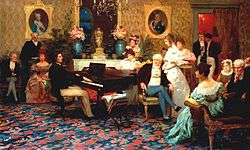The Reich Chancellery and Führerbunker Complex
 | |
| Author | Steven Lehrer |
|---|---|
| Original title | The Reich Chancellery and Führerbunker Complex: An Illustrated History of the Seat of the Nazi Regime |
| Country | United States |
| Language | English |
| Genre | Nonfiction/History |
| Published | 2006 (McFarland & Company) |
| Media type | Print (Hardcover) |
| Pages | 214 (hardcover edition) |
| ISBN | 978-0-7864-2393-4 (hardcover edition) |
| Preceded by | Hitler Sites |
The Reich Chancellery and Führerbunker Complex: An Illustrated History of the Seat of the Nazi Regime is a 2006 book by Steven Lehrer, in which Lehrer recounts the history of a group of Berlin buildings, from their construction in the 18th century until their complete destruction during and after World War II.

King Frederick William I of Prussia built the Palais Schulenburg, at Wilhelmstraße 77, for his esteemed Lieutenant General Count Adolph Friedrich von der Schulenburg.
Later the Palais had a more distinguished owner, Prince Anton Radziwill, a Polish-Lithuanian and Prussian nobleman, aristocrat, musician and politician. A guest at the Palais Radziwill was Polish composer and virtuoso pianist Frédéric Chopin.
During the Napoleonic Wars, Marshal Victor, the French Governor in Berlin, occupied the Palais.
In 1875 the feuding Radziwill heirs sold the Palais to the German Reich.
It became the Reichskanzlerpalais, the Chancellery of Otto von Bismarck and subsequent German Chancellors, the last being Adolf Hitler.[2]
Though Hitler lived in the old Chancellery when he was in Berlin, he ordered the building of a larger, grander structure, the New Reich Chancellery, completed January 1939. Hitler’s Reich Chancellery was not only a center of government but, in Winston Churchill’s words, the hub of “a monstrous tyranny never surpassed in the dark, lamentable catalogue of human crime.”
In April 1945, as the Soviet Army closed in, Hitler and his mistress, Eva Braun, committed suicide together in the Führerbunker which Hitler had built under the Chancellery garden.[3][4]
Notes
- ↑ "Chopin u Radziwiłła-Berlin 1829" by Henryk Siemiradzki in: Biblioteka chopinowska: Tom 7, 1960; Frédéric Chopin as a Man and Musician by Frederick Niecks; Chopin: The Man and His Music by James Huneker
- ↑ Hermann Pünder. Zur Geschichte des Reichskanzlerpalais und der Reichskanzlei. Herausgegeben vom Staatssekretär der Reichskanzlei. Festschrift zur Grundsteinlegung des neuen Dienstgebäudes der Reichskanzlei am 18. Mai 1928. Berlin. Zentralverlag 1928.
- ↑ Dietmar Arnold. Neue Reichskanzlei und »Führerbunker«. Legenden und Wirklichkeit. Ch. Links Verlag. Berlin 2006
- ↑ Dietmar Arnold, Ingmar Arnold. Dunkle Welten: Bunker, Tunnel und Gewölbe unter Berlin. Ch. Links Verlag. Berlin 2004
External links
| Wikimedia Commons has media related to Palais Radziwill (Berlin). |